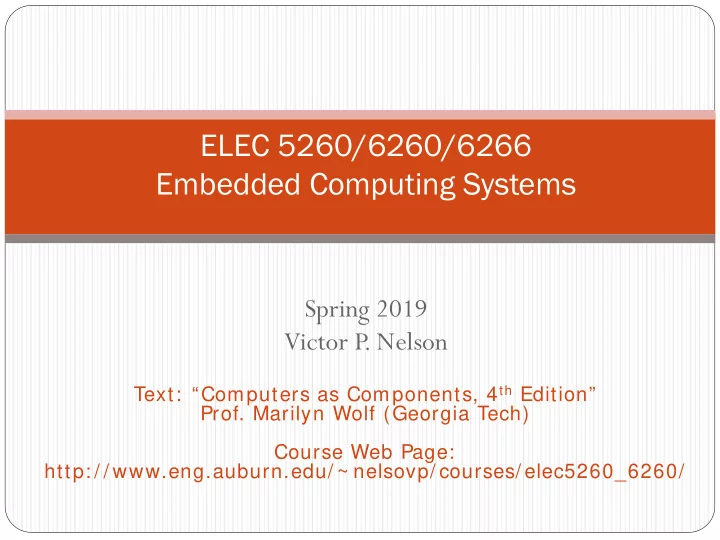

ELEC 5260/6260/6266 Embedded Computing Systems Spring 2019 Victor P . Nelson Text: “Computers as Components, 4 th Edition” Prof. Marilyn Wolf (Georgia Tech) Course Web Page: http: / / www.eng.auburn.edu/ ~ nelsovp/ courses/ elec5260_6260/
Course Topics (1) Embedded system design and implementation The embedded computing space – what is “embedded computing”? System design methodologies (including UML) Platforms: system-on-chip (SoC), microcontrollers, FPGAs, networks. CPUs for embedded systems (ARM, DSP) ARM Cortex-M4 and “Discovery Kit” development board System architectures, applications, methodologies. Hardware, software, system. Hierarchical software design for embedded systems (continued)
Course Topics (continued) Input/output devices, interrupts, timing Sensors, data acquisition, and control systems Real-time operating systems for embedded systems Internet of Things, IoT networks Automotive and Aerospace systems Standards-based design. Case studies This is not simply a “microcontroller course”.
Introduction to embedded systems What is an embedded system? Application-specific computer system Component of a larger system Interacts with its environment embedded system Often has real-time computing constraints Embedded Computer Output to Input from Software environment environment Hardware User interface Link to other systems
Benefits of Embedded Computer Systems Greater performance and efficiency Software makes it possible to provide sophisticated control Integrated functions often more efficient than external ones Lower costs Less expensive components can be used Manufacturing, operating, and maintenance costs reduced More features Many not possible or practical with other approaches Better dependability/security Adaptive system which can compensate for failures Better diagnostics to improve repair time Potential for distributed system design Multiple processors communicating across a network can lower parts and assembly costs and improve reliability
Application examples Simple control: microwave oven front panel Canon EOS 3 has three microprocessors. 32-bit RISC CPU runs auto-focus and eye control systems. Digital TV: programmable CPUs + hardwired logic. Smart phone: keyboard, communications, games, app’s Internet of Things (IoT) - distributed sensors/controllers Vehicle control (automotive, aerospace, etc.) Industrial process control (nuclear power plant) OTHER EXAMPLES?? ASSIGNMENT #1: 4-page report on a current multimedia system/device or an IoT system
Example embedded system: bike computer Functions Speed and distance measurement Constraints Input: Wheel rotation Size Mode key Cost Power and energy Weight Inputs Wheel rotation indicator Output: Mode key Display speed Output and distance Liquid Crystal Display Use Low Performance Microcontroller 8-bit, 10 MIPS
Gasoline automobile engine control unit Functions Many inputs and outputs Fuel injection Discrete sensors & actuators Network interface to rest of car Air intake setting Spark timing Use high performance microcontroller Exhaust gas circulation e.g. 32-bit, 3 MB flash memory, Electronic throttle control 150 - 300 MHz Knock control Constraints Reliability in harsh environment Cost Weight
Embedding a computer output “device” “device” input CPU mem embedded computer
Options for Building Embedded Systems Implementation Design Unit Upgrades Size Weight Power System Cost Cost & Bug Speed Fixes Dedicated Hardware low mid hard large high ? very fast Discrete Logic ASIC high very low hard tiny - 1 die very low low extremely ($500K/ fast mask set) low mid easy small low medium to very fast Programmable logic – high FPGA, PLD Microprocessor + low to mid mid easy small to low to medium moderate Software Running on Generic Hardware med. moderate memory + peripherals low mid to low easy small low medium slow to Microcontroller (int. moderate memory & peripherals) low high easy medium moderate medium to fast Embedded PC to high high
Microprocessors vs custom circuits? Microprocessors can be very efficient: Use same logic to perform many different functions. Create families of products. Create upgradable systems. Alternatives: Custom System on Chip (SoC) implemented with ASICs, field- programmable gate arrays (FPGAs), etc. May or may not include microprocessor “Platform” FPGA – implement one or more microprocessor hard/soft cores, with embedded memory and programmable logic
Microprocessor options Microcontroller: includes I/O devices, on-chip memory. Digital signal processor (DSP): microprocessor optimized for digital signal processing. Application-Specific Processor (ASP): instruction set & architecture tailored to application (graphics, network, etc.) Soft core: microcontroller or CPU model to be synthesized into a system on chip (SoC) Hard core: microcontroller or CPU implemented as part of a SoC, “platform FPGAs”
Early history Late 1940’s: MIT Whirlwind computer was designed for real-time operations. Originally designed to control an aircraft simulator. HP-35 calculator used several chips to implement a microprocessor in 1972. First microprocessor was Intel 4004 in early 1970’s. 4-bit microcontrollers created in the 1970’s 8-bit microcontrollers in mid 1970’s and so on …
Early history, continued. Automobiles have used microprocessor-based engine controllers starting in 1970’s. Control fuel/air mixture, engine timing, etc. Multiple modes of operation: warm-up, cruise, hill climbing, etc. Provides lower emissions, better fuel efficiency. High-performance 32- and 64-bit microcontrollers enable movement of functions from HW to SW Radio. Multimedia. Communications Complex control. Networks of lower-level microcontrollers distribute tasks
Automotive embedded systems High-end automobile may have dozens of microprocessors: 8-bit microcontroller checks seat belt; Microcontrollers run dashboard devices; 16/32-bit microprocessor controls engine. Network of microcontrollers control antilock brakes Entertainment systems Navigation systems Collision avoidance Autonomous operation (self-driving)
BMW 850i brake & stability control system Anti-lock brake system (ABS) Pump brakes to reduce skidding. Automatic stability control + traction (ASC+T) Control engine to improve stability (throttle, ignition timing, differential brake, gears). ABS and ASC+T communicate. ABS was introduced first---needed to interface to existing ABS module. Diagram – next slide
BMW 850i, cont’d. sensor sensor brake brake hydraulic ABS pump brake brake sensor sensor
High-end embedded system characteristics Complex algorithms: high performance & functionality. High data rates Large data structures Varied user/device interfaces. Multiple tasks, heterogeneous. Real-time operation/precise timing. Low-power operation. Safe, reliable, secure operations. Manufacturable, sustainable, cost-effective. Often have to make trade-offs to meet constraints
Challenges in embedded system design How much hardware do we need? CPU computing power? Memory? What peripheral functions? Implement in HW or SW? How do we meet timing constraints? Faster hardware or cleverer software? Real-time operating system or custom design? How do we minimize power consumption? How do we optimize cost? How do we ensure system security/reliability? How do we meet our time-to-market deadline?
Recommend
More recommend